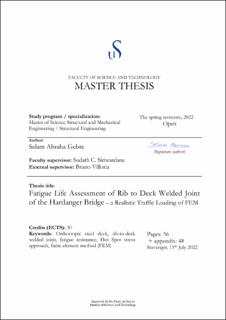| dc.description.abstract | The orthotropic steel decks in the Hardanger Bridge, as is common for long span suspension bridges, have welded joints that are susceptible to fatigue cracks. The rib-to-deck welded joints under the wheel load are the most common crack initiation sites. Crack in the weldment accelerates the degradation of other components of the bridge deck and ultimately shortens the fatigue life of the road bridge. The fatigue life of the rib-to-deck welded joint is determined by using Miner’s damage accumulation rule of the rainflow cycle counted stress ranges of the nominal and Hot Spot stresses.
A full-scale 20 m long finite element model of the box girders in the Hardanger Bridge was built following the design drawings provided by the Norwegian Public Road Administration (NPRA). The model was loaded with fatigue load models (FLM) in Abaqus. A realistic dynamic design of the FLM traffic loading on the bridge was achieved by user subroutine. The thesis compared the fatigue life of two fatigue load models, the national (FLM-N) and Eurocode’s FLM4. The effect of velocity on fatigue life of the welded joint was assessed by simulating vehicle with three different velocities while ensuring equal sampling rate. A validated whole span global model of Hardanger Bridge was provided for this thesis. The global model was loaded by vehicle equivalent concentrated load and corresponding moment of FLM-N and FLM-4. Stress response calculated from moment and axial force was used to estimate fatigue life.
The fatigue load models cause high cycle fatigue damage on the welded joints of the orthotropic steel decks of the Hardanger Bridge. The Hot Spot stress fatigue life of the welded rib-to-deck joint was 135 years (FLM-N) and 24 years (FLM4). The corresponding nominal stress fatigue life was 1180 years (FLM-N). Stresses from loading the global model with a single vehicle at a time did not induce fatigue damage. The effect of velocities of the vehicles loaded resulted in insignificant changes of the fatigue life of the welded joint. | |
